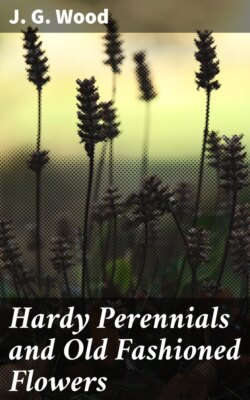Читать книгу Hardy Perennials and Old Fashioned Flowers - J. G. Wood - Страница 59
На сайте Литреса книга снята с продажи.
Chrysanthemum.
ОглавлениеTable of Contents
Nat. Ord. Compositæ.
The flowers to which I would now refer the reader are of no particular species, but, like several other genera, this genus has been considerably drawn upon or utilised by the hybridiser, and the species, looked upon from a florist's point of view, have been much improved upon by their offspring. Not only are Japan and China the homes of the finer flowering species, but in these countries the Chrysanthemum has been esteemed and highly cultivated for centuries; in fact, such a favourite is this flower with the Chinese, that they have treated it with many forms of their well-known art in matters horticultural, and when the flower was brought to this country it would doubtless be in a form improved by them. It reached this country nearly 100 years ago, and was known by the names C. indicum and C. sinense; about the same time a species from the East Indies was called C. indicum. This flower, from the time of its introduction, has been justly appreciated; and by the skill of several cultivators we have a largely increased number of forms and colours. Still, there are certain distinctions kept up amongst the varieties, and they are commonly known by such names as "large-flowering," "pompon, or small-flowered," "early flowering," "anemone-flowered," and "Japanese." These names, besides being somewhat descriptive, are otherwise useful to the amateur who may wish to grow a representative collection, and where there is convenience it is desirable to do so in order to observe their widely different forms and colours, as well as to enjoy a long succession of bloom.
So well is the Chrysanthemum known that little could be usefully said of it by way of description; but well as it is known and easy as its culture is, there are few things in our gardens that show to greater disadvantage. This should not be with a subject which offers such range of habit, colour, and period of blooming; and when such is the case, there must be some radical mistake made. The mistake I believe to be in the selection, and that alone. If so, the remedy is an easy matter. Let me ask the reader to remember three facts: (1) Many sorts grown in pots and flowered under glass are unfitted for the borders or open garden. (2) The later flowering varieties are of no use whatever for outside bloom. (3) Of the early blooming section, not only may the finest varieties be grown with marked effect, but they, as a rule, are of more dwarf habit, and will afford abundance of bloom for cutting purposes for nearly two months. Selections are too often made from seeing the fine sorts in pots; let it be understood that all are perfectly hardy, but owing to their lateness, their utility can only be realised under artificial conditions. I am not now considering pot, but garden kinds, and no matter what other rules may be observed, if this is overlooked it will be found that though the plant may grow finely and set buds in plenty, they will be so late as to perish in their greenness by the early frosts; on the other hand, of the early section, some will begin to bloom in August, and others later, each kind, after being covered with flowers for several weeks, seeming to finish naturally with our season of flowers.
There is nothing special about the culture of this very hardy and rampant-growing plant, but I may add that, though it will stand for many years in one place, and flower well too, it is vastly improved by division of the roots in autumn or early spring every second year. The earth of its new site should be deeply dug and well enriched with stable manure; it will not then matter much what sort of soil it is—the more open the situation the better. How grandly these decorate the borders when in masses! and as a cut flower I need hardly say that there are few to excel the Chrysanthemum, either as an individual bloom or for bouquet and other work.
I do not frequently make mention of many florists' flowers by name, but in this case I think I may usefully name a few varieties: Andromeda, cream coloured, Sept.; Captain Nemo, rosy purple, Aug.; Cassy, pink and white, Oct.; Cromatella, orange and brown, Sept.; Delphine Caboche, reddish mauve, Aug.; Golden Button, small canary yellow, Aug.; Illustration, soft pink to white, Aug.; Jardin des Plantes, white, Sept.; La Petite Marie, white, good, Aug.; Madame Pecoul, large, light rose, Aug.; Mexico, white, Oct.; Nanum, large, creamy blush, Aug.; Précocité, large, orange, Sept.; Sœur Melaine, French white, Oct.; St. Mary, very beautiful, white, Sept. These, it will be seen, are likely to afford a variety and succession of bloom.
Flowering period, August to November.
